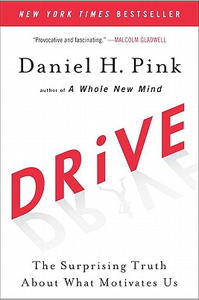How TODAY'S SCHOOL DISTRICT
SUPPRESSES LEARNING MOTIVATION

NEW SCIENCE
On December 19, 2009 — not that long ago — a very influential book was published:
Daniel H. Pink's book DRIVE: The Surprising Truth About What Motivates Us.
Brilliantly summarizing insights from over five decades of scientific research into motivation, this book changed the minds of many about what truly motivates us.
The book was on the New York Times bestseller lists (main and extended) for 159 weeks.
It has been translated into 42 languages.
Extrinsic versus Intrinsic motivation
In Drive, Mr. Pink tells us everything we need to know about when to use extrinsic motivation (carrots and sticks) and when and how to activate intrinsic motivation.
Importantly, Mr. Pink gives us the scientific knowledge to understand why intrinsic motivation is best suited for the kind of creative problem solving and learning most desired from a good education – and the ideal conditions for releasing this powerful drive.

Extrinsic motivation
Extrinsic comes from outside: rewards and punishments, often referred to as carrots and sticks.
It turns out that extrinsic motivation (rewards) works well for simple learning, such as memorizing multiplication.
For deeper learning extrinsic motivation not only does NOT work it measurably slows down the learning.
This surprising truth is not easy to accept, but the science is overwhelming. (Read the book.)
That conclusion explains why so many initiatives have not worked.
Merit pay for teachers, for example, has been tried many times, but has never worked.
Grades? Punishing students for not learning? If any of these extrinsic motivations were truly effective...they would have worked by now. But they haven't.

Intrinsic motivation
If a student doesn't seem motivated, the right conditions are not present.
These motivating conditions are not optional, as complex concepts, problem solving, writing — all of these require true human engagement — engagement that can ONLY come from WITHIN the student.
What ACTIVATES this drive INSIDE students?
Three (3) conditions are SCIENTIFICALLY PROVEN to activate intrinsic motivation:
1. AUTONOMY
NOT control, compliance. NOT learn this. Stop. Now learn that.
2. MASTERY
A challenge not TOO DIFFICULT (frustrating), not TOO EASY (boring), but just right, IN-THE-ZONE.
And JUST-IN-TIME feedback. Once one is in the zone, one wants to see if one is progressing, without having to wait to find out.
3. PURPOSE
A good reason to learn something or an INNER interest.
Today's school district suppresses all three motivating conditions.

1. AUTONOMY
Teachers don't have autonomy in school. Neither do students.
There is a schedule of lessons to follow.
Teach this. Stop. Now teach that.
Learn this. Stop. Now learn that.
2. MASTERY
As the learning challenges are ONE-SIZE-FITS-ALL, naturally, for different students the challenges are TOO DIFFICULT or TOO EASY.
Instead of JUST-IN-TIME feedback, tests are spaced out by weeks.
3. PURPOSE
Why, a student might ask, am I sitting hear listening to what I can't understand or have already learned?
There is nothing built into this system to methodically help students discover and involve their own interests.
In this way ALL THREE conditions SCIENTIFICALLY PROVEN to ACTIVATE learning motivation are SUPPRESSED.
School districts thus SUPPRESS ALL THREE conditions SCIENTIFICALLY PROVEN to ACTIVATE learning motivation.